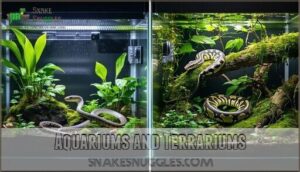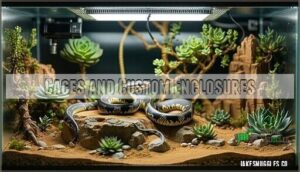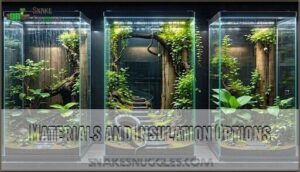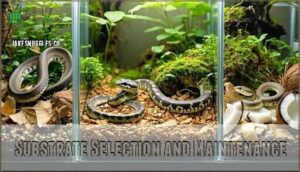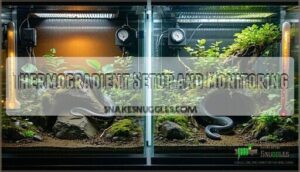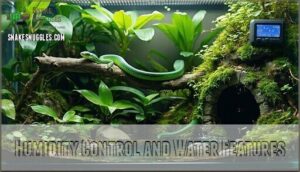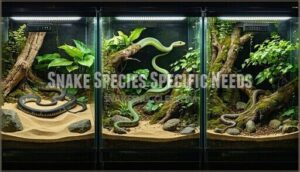This site is supported by our readers. We may earn a commission, at no cost to you, if you purchase through links.
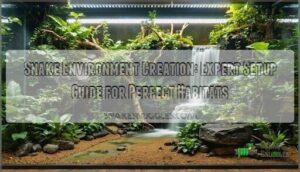
You’ll need to master temperature gradients, humidity levels, and proper substrate choices that mimic their natural habitat.
Snake environment creation isn’t just about throwing together a glass box and calling it home.
Your setup requires strategic placement of hiding spots, water features, and climbing structures that encourage natural behaviors.
Most keepers underestimate how vital proper ventilation and lighting cycles are for maintaining health.
The secret lies in species-specific research, since a ball python’s needs differ dramatically from a corn snake’s requirements.
Getting these basics right sets the foundation for advanced techniques.
Table Of Contents
- Key Takeaways
- Snake Habitat Essentials
- Enclosure Selection Guide
- Creating Natural Environment
- Snake Species Specific Needs
- Maintaining Healthy Environment
- Frequently Asked Questions (FAQs)
- What kind of environment do snakes need?
- How did snakes come to existence?
- What attracts snakes to the yard?
- How often should snake enclosures be cleaned?
- What plants are safe for snake habitats?
- How to prevent snake escapes from enclosures?
- What backup heating options during power outages?
- How to quarantine new snakes safely?
- Conclusion
Key Takeaways
- Create precise temperature gradients – You’ll need heating elements with thermostats to maintain 70-85°F ranges with basking spots at 90-100°F, as your snake’s health depends on proper thermoregulation.
- Research your species’ specific needs – You cannot use the same setup for all snakes, since ball pythons and corn snakes have dramatically different humidity, space, and environmental requirements.
- Monitor humidity and ventilation carefully – You’ll prevent respiratory issues and support healthy shedding by maintaining species-appropriate humidity levels (30-80%) with proper airflow systems.
- Provide adequate space and enrichment – You need enclosures that allow full body extension plus 50% extra length, with secure hiding spots and climbing structures that encourage natural behaviors.
Snake Habitat Essentials
Creating a thriving snake habitat requires careful attention to four essential elements that directly impact your pet’s health and well-being.
You’ll need to master temperature gradients, humidity levels, proper lighting cycles, and adequate space with appropriate hiding spots to replicate your snake’s natural environment successfully, including proper lighting cycles.
Temperature and Humidity Control
Temperature control creates the foundation of snake health. You’ll need heating elements like heat mats or ceramic heaters, paired with thermostats to maintain precise temperature ranges.
Create a gradient from 70-85°F, allowing thermoregulation. Humidity monitoring requires digital hygrometers, with levels varying by species—tropical snakes need 60-80% humidity, while desert species thrive at 30-50%.
Many keepers source their snake heating mats from online retailers. Proper humidity control prevents respiratory issues and supports healthy shedding.
Lighting and Ventilation Systems
Proper lighting creates diurnal cycles that regulate your snake’s natural rhythm, with 12-14 hours of daily illumination supporting healthy behavior.
UVB benefits certain species by mimicking natural sunlight, though research your snake’s specific needs first. Consider snake UVB options when setting up your terrarium.
Meanwhile, ventilation prevents stagnant air and mold prevention through consistent airflow patterns. Position intake and exhaust vents strategically to maintain proper airflow without creating drafts.
System automation using timers guarantees consistent lighting schedules while maintaining stable humidity and temperature stability throughout your enclosure.
Space and Movement Requirements
Your snake’s enclosure size directly impacts its Activity Levels and overall well-being. Smaller snakes need space to stretch fully, while larger snakes require proportionally more room to prevent overcrowding prevention issues.
Your snake needs room to move, stretch, and thrive—cramped spaces create stressed, unhealthy reptiles.
Adequate Stretching Space supports natural Behavioral Needs and prevents Growth Impact problems that occur in cramped environments. To guarantee a healthy environment, remember to prioritize proper ventilation systems.
Key Enclosure Enrichment considerations:
- Enclosure size should equal or exceed your snake size in length
- Provide multiple levels for climbing species to increase usable space
- Regular assessment guarantees growing snakes maintain appropriate room for movement
Hiding Places and Decorations
Beyond adequate space, your snake’s mental wellbeing depends on proper hiding spots and thoughtful decorations.
Secure hides reduce stress by providing safe retreats, while enrichment items encourage natural behaviors.
Size appropriateness matters—hides should snugly fit your snake without being cramped.
| Hide Type | Benefits | Placement | Maintenance |
|---|---|---|---|
| Warm Hide | Thermoregulation, security | Hot side of enclosure | Weekly spot cleaning |
| Cool Hide | Temperature regulation | Cool side of enclosure | Monthly deep clean |
| Humid Hide | Shedding assistance | Middle zone preferred | Replace substrate regularly |
| Naturalistic Decor | Behavioral enrichment | Throughout habitat | Sanitize during cleaning |
Cleaning decor regularly prevents bacterial growth while maintaining your snake’s naturalistic environment.
Enclosure Selection Guide
Selecting the right enclosure for your snake isn’t just about picking any box that fits—it’s about choosing a home that supports your snake’s health, behavior, and long-term well-being.
You’ll need to weigh factors like ventilation, insulation, visibility, and customization options to create an environment where your snake can thrive naturally.
Aquariums and Terrariums
When choosing between glass and PVC enclosures, consider your snake’s specific needs.
Glass aquariums offer excellent visibility and cleaning ease, but struggle with ventilation concerns and humidity control.
Terrariums provide better airflow and temperature regulation, and both face size limitations compared to custom options.
Consider that certain setups may require specialized snake habitat products, and focus on habitat design that supports your snake’s natural behaviors through proper enclosure setup and enrichment options, which are key to creating a suitable environment for your snake’s natural behaviors.
Cages and Custom Enclosures
Commercial cages offer versatility while custom enclosures provide personalized solutions for your snake environment needs.
Both options require careful planning to guarantee proper enclosure security and functionality for your reptile companion.
- Cage Materials – Choose wood, plastic, or metal based on durability and maintenance requirements
- Custom Aesthetics – Design personalized features that complement your home while meeting species needs
- DIY Projects – Build cost-effective solutions with proper ventilation and Size Considerations for ideal terrarium functionality
Materials and Insulation Options
Material selection makes or breaks your snake’s long-term health.
Glass provides excellent visibility but struggles with insulation properties, while PVC offers superior temperature retention and lightweight handling.
Wood creates natural aesthetics but requires careful sealing against humidity damage.
| Material | Insulation Properties | Cost Analysis | Aesthetic Appeal | DIY Options | Maintenance |
|---|---|---|---|---|---|
| Glass | Poor heat retention | Moderate initial cost | Clean, professional look | Limited customization | Easy cleaning |
| PVC | Excellent insulation | Higher upfront investment | Modern appearance | Moderate DIY potential | Simple upkeep |
| Wood | Good natural insulation | Variable by wood type | Natural, warm feel | High DIY flexibility | Regular sealing needed |
| Melamine | Decent thermal properties | Budget-friendly option | Basic functionality | Easy DIY assembly | Moisture-resistant |
| Acrylic | Moderate insulation | Premium pricing | Crystal-clear viewing | Professional installation | Scratch-prone surface |
Your terrarium material directly affects substrate temperature gradients and humidity control.
PVC enclosures maintain stable conditions with minimal energy costs, while glass requires additional heating elements to compensate for heat loss.
Creating Natural Environment
Creating a natural environment for your snake goes beyond just providing basic shelter—it’s about recreating the conditions that promote natural behaviors and reduce stress.
You’ll need to carefully balance substrate selection, temperature gradients, humidity levels, and environmental features to create a habitat that truly mimics your snake’s wild home, which is essential for promoting natural behaviors.
Substrate Selection and Maintenance
Substrate selection forms the foundation of your snake’s comfort and health.
Choose aspen shavings for excellent burrowing behavior support, cypress mulch for superior humidity retention, or coconut fiber for natural bioactive substrates.
Avoid cedar or pine due to toxicity, and sand that creates impaction risks.
Maintain substrate depth of 2-4 inches, perform daily spot cleaning for odor control, and replace soiled substrate monthly to guarantee mold prevention.
Thermogradient Setup and Monitoring
Your snake’s temperature gradient creates the foundation for proper thermoregulation. Position heating elements like heat lamps or ceramic emitters on one side, creating a warm basking spot (90-100°F) and cool retreat (70-75°F).
Use thermostats to prevent overheating and digital thermometers for accurate monitoring across different zones.
- Watch your snake’s behavior – they’ll tell you if temperatures are right by their positioning
- Calibrate thermostats regularly – a few degrees off can mean the difference between health and illness
- Monitor multiple zones daily – temperature variations affect digestion, activity, and overall wellbeing
Humidity Control and Water Features
Managing humidity correctly creates the foundation for your snake’s health, with tropical species requiring 60-80% levels while desert species thrive at 30-50%.
Install misting systems for consistent humidity adjustment, or use a misting bottle for smaller setups. Position water bowls strategically to boost ambient moisture, and add humid hides filled with damp sphagnum moss for species needs.
Monitor humidity levels with digital hygrometers, ensuring proper ventilation prevents mold prevention issues that compromise air quality, which is crucial for maintaining the health of your snake.
Natural Perches and Branches
Several well-placed climbing structures transform your snake’s enclosure into an enriching vertical playground.
Natural perches provide essential climbing enrichment while mimicking your snake’s natural habitat perfectly. A temperature gradient is also essential for thermoregulation.
- Perch Diameter: Choose branches 1-2 times your snake’s body width for comfortable gripping and secure attachment points
- Branch Material: Use hardwood branches like oak or maple, avoiding soft woods that splinter or contain harmful oils
- Perch Placement: Position climbing structures at varying heights to create multiple basking zones and exploration opportunities
Snake Species Specific Needs
Creating habitats for different snake species requires understanding their unique environmental needs, which vary substantially based on their natural origins.
You’ll need to research each species’ native habitat conditions, including temperature ranges, humidity levels, space requirements, and lighting preferences, to replicate these conditions successfully in captivity, considering their unique environmental needs.
Researching Native Environments
Understanding your snake’s origins transforms good husbandry into great care.
Habitat mapping reveals whether your species thrives in rainforests, deserts, or grasslands, while dietary analysis uncovers natural feeding patterns.
Snake behavior studies show how environmental factors like humidity and temperature cycles shape natural behaviors.
Conservation status research provides additional insights into habitat requirements.
This groundwork guarantees your artificial environment mirrors the natural habitat your snake species evolved to inhabit, considering factors like temperature cycles and ensuring a suitable environment, which is crucial for great care.
Temperature and Humidity Requirements
Once you’ve mapped your snake’s native habitat, you’ll need to create precise temperature and humidity conditions.
Most species require a temperature gradient from 70-85°F with basking spots reaching 90-100°F.
Use heating elements like under-tank heaters or ceramic emitters controlled by thermostats.
Monitor conditions with digital thermometers and hygrometers.
Tropical species need 60-80% humidity, while desert species thrive at 30-50%.
This gradient importance can’t be overstated—proper thermostat use prevents overheating and guarantees your snake’s species needs are met through consistent humidity monitoring.
Space and Movement Needs
Your snake’s enclosure size directly impacts its physical health and mental well-being. Each species has unique spatial requirements that go beyond simple length measurements, affecting how they move, hunt, and rest.
- Enclosure size must allow full body extension plus 50% additional length for natural stretching space and behavioral needs
- Vertical space becomes essential for arboreal species, requiring height equal to two-thirds of their body length for proper climbing
- Growth considerations demand regular enclosure upgrades as juveniles mature, with snake enclosure dimensions adjusted every 6-12 months
Snake exercise and snake enrichment depend on adequate room for natural movement patterns. Activity levels vary by species, but all snakes need space to explore, thermoregulate, and exhibit normal behaviors without restriction. Remember to provide ample space for movement to guarantee your snake thrives.
Lighting and Ventilation Requirements
Light-spectrum mastery determines your snake’s health through precise UVB benefits and diurnal cycles.
Arboreal species need stronger UVB lighting than terrestrial ones, while nocturnal snakes require gentler basking lamps with consistent light cycles.
Smart airflow design prevents respiratory issues through cross-ventilation, reducing mold prevention concerns.
Balance lighting conditions with proper ventilation to maintain species-specific requirements without compromising humidity levels, ensuring a healthy environment through diurnal cycles and proper ventilation.
Maintaining Healthy Environment
Once you’ve set up your snake’s habitat, maintaining it properly becomes your most important daily responsibility.
Regular monitoring and cleaning guarantee your snake stays healthy and stress-free in its carefully crafted environment.
Regular Cleaning and Maintenance
Cleanliness forms the foundation of your snake’s health, preventing disease and stress through consistent maintenance routines.
Establish systematic cleaning protocols to maintain ideal habitat conditions.
- Waste Removal – Remove feces and urates immediately upon discovery
- Disinfection Protocols – Clean surfaces weekly with reptile-safe disinfectants
- Water Changes – Replace water every 3-5 days or when soiled
- Mold Prevention – Remove damp substrate and debris promptly
Monitoring Temperature and Humidity
Daily monitoring becomes your lifeline for snake health.
Digital thermometers and hygrometers provide accurate readings, while humidity probes track moisture levels throughout the enclosure.
Remote monitoring systems with data logging capabilities let you spot temperature fluctuations before they become problems.
Thermostat calibration guarantees your heating elements maintain consistent temperatures, preventing dangerous spikes that could harm your snake, which is crucial for maintaining the overall snake health.
Providing Fresh Water and Food
Water availability and feeding schedules form the foundation of proper snake husbandry.
You’ll need to provide consistent access to clean drinking water and establish appropriate feeding routines for ideal nutrition and hydration.
- Maintain fresh water sources – Replace water weekly, ensuring bowls are large enough for soaking and cleaned regularly to prevent bacterial growth through proper hygiene practices.
- Establish consistent feeding schedules – Feed juveniles weekly and adults every 2-3 weeks, selecting appropriate prey size based on your snake’s girth and species requirements.
- Monitor supplementation needs – Assess your snake’s body condition regularly, adjusting prey selection and feeding frequency to maintain healthy weight and prevent nutritional deficiencies.
Preventing Health Issues and Stress
Monitor your snake’s behavior closely, as subtle changes often signal health problems before they become serious.
Regular hygiene practices, proper quarantine protocols for new arrivals, and enrichment activities reduce stress levels substantially.
Early detection of respiratory issues or skin infections through daily observation guarantees prompt treatment and better outcomes for your snake’s wellbeing.
Maintaining a clean enclosure helps prevent common snake diseases, which is crucial for preventing serious issues.
Frequently Asked Questions (FAQs)
What kind of environment do snakes need?
You’d think these slithery escape artists would be low-maintenance, but they’re surprisingly picky about their real estate.
Snakes need temperature gradients, proper humidity, secure hiding spots, and appropriately-sized enclosures for ideal health, which includes secure hiding spots.
How did snakes come to existence?
You’ll discover that snakes evolved from ancient lizard ancestors around 150 million years ago, gradually losing their limbs through mutations that favored burrowing lifestyles underground.
What attracts snakes to the yard?
You’re basically running a snake buffet when you’ve got shelter, food, and water readily available.
Rodents, dense vegetation, brush piles, and standing water create perfect hunting grounds that’ll draw them right in.
How often should snake enclosures be cleaned?
Your snake’s sanctuary needs housekeeping about once weekly, though spot-cleaning waste happens immediately.
You’ll deep-clean monthly, replacing substrate and disinfecting surfaces to prevent bacterial buildup that compromises your pet’s health and comfort, ensuring a clean and safe environment for your pet.
What plants are safe for snake habitats?
Safe plants for snake habitats include pothos, snake plants, spider plants, and bromeliads.
You’ll want to avoid toxic varieties like philodendrons, ivy, or anything with sharp edges that could injure your snake during exploration.
How to prevent snake escapes from enclosures?
Nearly 80% of snake escapes occur due to inadequate lid security, making proper enclosure closure your top priority.
You’ll need secure, locking lids with proper ventilation, tight-fitting doors, and regular inspections for gaps or wear to prevent escapes effectively.
What backup heating options during power outages?
During power outages, you’ll need backup heating like heat packs, portable generators, or battery-powered heaters.
Keep extra blankets handy, move your snake to a warmer room, and monitor temperatures closely until power returns.
How to quarantine new snakes safely?
Quarantine isn’t just cautious—it’s your snake’s lifeline against invisible threats. You’ll need a separate room with proper heating, lighting, and ventilation for thirty days minimum before introducing newcomers.
Conclusion
Building your perfect snake environment creation system transforms your pet’s simple cage into a thriving ecosystem that mirrors nature’s complexity.
Your snake’s health depends on consistent monitoring, proper maintenance, and attention to environmental details.
Remember that successful snake environment creation requires patience and ongoing adjustments as you observe your pet’s behavior and responses to their carefully crafted home, which includes understanding temperature gradients and species-specific requirements.

